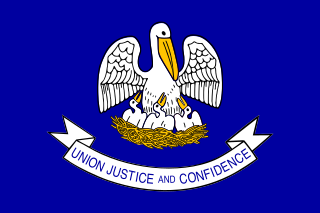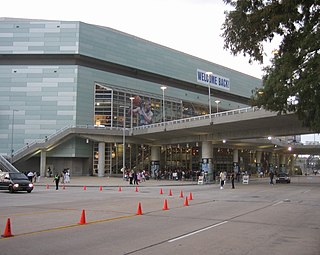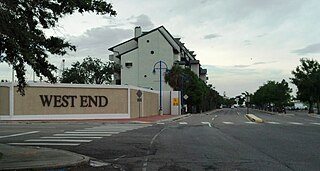Metroblogging was an online local media project founded by Jason DeFillippo and Sean Bonner, subsequently owned by Sean Bonner, Jason DeFillippo and Richard Ault, collectively Bode Media, Inc. Started in Los Angeles in November 2003, the project included 57 city-specific blogs around the world, with close to 700 contributors. Notable contributors have included Xeni Jardin and Wil Wheaton, Violet Blue, Johannes Grenzfurthner (Vienna), Aaron Proctor (Philadelphia) and Joi Ito (Tokyo).

Hurricane Katrina was a devastating Category 5 Atlantic hurricane that resulted in 1,392 fatalities and caused damage estimated between $97.4 billion to $145.5 billion in late August 2005, particularly in the city of New Orleans and its surrounding areas. At the time, it was the costliest tropical cyclone on record, tied now with Hurricane Harvey of 2017. Katrina was the twelfth tropical cyclone, the fifth hurricane, and the third major hurricane of the 2005 Atlantic hurricane season. It was also the fourth-most intense Atlantic hurricane on record to make landfall in the contiguous United States.

As the center of Hurricane Katrina passed southeast of New Orleans on August 29, 2005, winds downtown were in the Category 1 range with frequent intense gusts. The storm surge caused approximately 23 breaches in the drainage canal and navigational canal levees and flood walls. As mandated in the Flood Control Act of 1965, responsibility for the design and construction of the city's levees belongs to the United States Army Corps of Engineers and responsibility for their maintenance belongs to the Orleans Levee Board. The failures of levees and flood walls during Katrina are considered by experts to be the worst engineering disaster in the history of the United States. By August 31, 2005, 80% of New Orleans was flooded, with some parts under 15 feet (4.6 m) of water. The famous French Quarter and Garden District escaped flooding because those areas are above sea level. The major breaches included the 17th Street Canal levee, the Industrial Canal levee, and the London Avenue Canal flood wall. These breaches caused the majority of the flooding, according to a June 2007 report by the American Society of Civil Engineers. The flood disaster halted oil production and refining which increased oil prices worldwide.

Criticism of the government response to Hurricane Katrina was a major political dispute in the United States in 2005 that consisted primarily of condemnations of mismanagement and lack of preparation in the relief effort in response to Hurricane Katrina and its aftermath. Specifically, there was a delayed response to the flooding of New Orleans, Louisiana.

The disaster recovery response to Hurricane Katrina in late 2005 included U.S. federal government agencies such as the Federal Emergency Management Agency (FEMA), the United States Coast Guard (USCG), state and local-level agencies, federal and National Guard soldiers, non-governmental organizations, charities, and private individuals. Tens of thousands of volunteers and troops responded or were deployed to the disaster; most in the affected area but also throughout the U.S. at shelters set up in at least 19 states.

This article contains a historical timeline of the events of Hurricane Katrina on August 23–30, 2005 and its aftermath.
Interdictor is the name of a LiveJournal blog that documented the effects of Hurricane Katrina in New Orleans during and following the destruction. It is operated by Michael Barnett. At the time he was an employee of Directnic.com, an internet services company on the 10th and 11th floors of an office building in downtown New Orleans at 650 Poydras Avenue, which he referred to as "Outpost Crystal". Daniel Gifford, another employee of directNIC.com, also contributed many articles to the blog. In the early aftermath of the hurricane and flooding, it was one of the few reliable communications links between downtown New Orleans and the rest of the world.

Ivor van Heerden holds a doctorate degree in Marine Sciences and was the deputy director of the Louisiana State University (LSU) Hurricane Center, before being dismissed by LSU with no reason given, following Hurricane Katrina. He is also the director of the Center for the Study of Public Health Impacts of Hurricanes.

Many representatives of the news media reporting on the aftermath of Hurricane Katrina became directly involved in the unfolding events, instead of simply reporting. Due to the loss of most means of communication, such as land-based and cellular telephone systems, field reporters in many cases became conduits for information between victims and authorities.

When the Levees Broke: A Requiem in Four Acts is a 2006 documentary film directed by Spike Lee about the devastation of New Orleans, Louisiana following the failure of the levees during Hurricane Katrina. It was filmed in late August and early September 2005, and premiered at the New Orleans Arena on August 16, 2006 and was first aired on HBO the following week. The television premiere aired in two parts on August 21 and 22, 2006 on HBO. It has been described by Sheila Nevins, chief of HBO's documentary unit, as "one of the most important films HBO has ever made." The title is a reference to the blues tune "When the Levee Breaks" by Kansas Joe McCoy and Memphis Minnie about the Great Mississippi Flood of 1927.

The New Orleans Yacht Club (NOYC) was founded in June 1949 and is dedicated to further the sport of yacht racing, marine safety and seamanship. The club is located at West End's Municipal Yacht Harbor on the south shore of Lake Pontchartrain and is a member of the Gulf Yachting Association since 1953.

Katrina refrigerators are refrigerators that were destroyed or rendered unusable during Hurricane Katrina on August 29, 2005, and their aftermath. Many were made into temporary folk art.

West End is a neighborhood of the city of New Orleans. A subdistrict of the Lakeview District Area, its boundaries as defined by the City Planning Commission are: Lake Pontchartrain to the north, the New Basin Canal and Pontchartrain Boulevard to the east, Veterans Boulevard to the south, and the 17th Street Canal to the west. The area was largely built on land reclaimed from Lake Pontchartrain. It is a commercial seafood and recreational boating hub for the city and has been known for its seafood restaurants. In recent years, the area has seen large condominium-complex developments built which overlook the Lake, marinas, and centrally located 30-acre (120,000 m2) West End Park.

Internally displaced persons in the United States are people from the Gulf States region in the southern United States, most notably New Orleans, Louisiana, who were forced to leave their homes because of the devastation brought on by Hurricane Katrina in 2005 and were unable to return because of a multitude of factors, and are collectively known as the Gulf Coast diaspora and by standard definition considered IDPs. At their peak, hurricane evacuee shelters housed 273,000 people and, later, FEMA trailers housed at least 114,000 households. Even a decade after Hurricane Katrina, many victims who were forced to relocate were still unable to return home.
While the term "blog" was not coined until the late 1990s, the history of blogging starts with several digital precursors to it. Before "blogging" became popular, digital communities took many forms, including Usenet, commercial online services such as GEnie, BiX and the early CompuServe, e-mail lists and Bulletin Board Systems (BBS). In the 1990s, Internet forum software, such as WebEx, created running conversations with "threads". Threads are topical connections between messages on a metaphorical "corkboard". Some have likened blogging to the Mass-Observation project of the mid-20th century.

A.D.: New Orleans After the Deluge is a non-fiction graphic novel by cartoonist Josh Neufeld. Originally published as a webcomic, A.D. tells the stories of a handful of real-life New Orleans residents and their experiences during and after Hurricane Katrina. The graphic novel was a New York Times best-seller and was nominated for an Eisner Award and a Harvey Award in 2010. In addition, A.D. was selected for inclusion in The Best American Comics 2010.

Hurricane Season is a 2009 American sports drama film directed by Tim Story and starring Forest Whitaker, Taraji P. Henson, Isaiah Washington, Lil Wayne, and Bow Wow. The screenplay was written by Robert Eisele and the film was produced by Raymond Brothers and Scott Glassgold. The film had been delayed several times and was sent straight to DVD on December 8, 2009.

Mike Theiss is a National Geographic photographer, on air talent, video producer, professional storm chaser. He is the CEO/Founder of Ultimate Chase Inc. that specializes in extreme nature photography. His work has been published in National Geographic magazine numerous times for displaying hurricanes, tornadoes, lightning, volcanoes, and other rare nature events.
Marion Abramson Senior High was a high school in the New Orleans East area of New Orleans, United States. The former Abramson campus is adjacent to Greater St. Stephen's Baptist Church. The school was operated by New Orleans Public Schools.
The Cajun Navy are informal ad hoc volunteer groups comprising private boat owners who assist in search and rescue efforts in the United States as well as offer disaster relief assistance. These groups were formed in the aftermath of Hurricane Katrina and reactivated in the aftermaths of the 2016 Louisiana floods, Hurricane Harvey, Hurricane Irma, the 2018 Hidalgo County flood, Hurricane Florence, Tropical Storm Gordon, Hurricane Michael, Hurricane Laura, Hurricane Ida, and Hurricane Ian They are credited with rescuing thousands of citizens during those disasters.










